The Ocarina of Time Manga and Its Affects on the Series
Posted on November 26 2008 by Nathanial Rumphol-Janc
Let’s get one thing straight. Manga has never been a part of my regular reading. In fact, my opinion on all anime has been nothing short of
loathing. Japanese culture has a tendency to be a bit extreme for my
taste, but once The Legend of Zelda got involved, it was too hard not
to take a look. After all, it has been almost a decade since Nintendo
has even tried to take the series into a multimedia format in North
America. Will this new manga properly represent the series, or will it
fall on its face like so many other shoddy attempts?
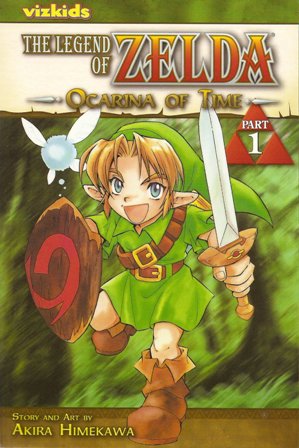
The
Legend of Zelda: Ocarina of Time manga was released in Japan, 1998,
written and drawn by Akira Himekawa, a collaborative pen name of two
women A. Honda and S. Nagano. The project consisted of two volumes, the
first consisting of six chapters, and the second with nine including
two additional side stories. Many fans fully translated both volumes of
the books, but it was not until ten years later that a publisher
officially translated the book for North America. Vizkids, a children’s
book publisher, shipped the book on October 7th. However the book was
not exactly easy to come by.
After two or three weeks of mild
searching, one copy was available for me at my nearby Barnes and Noble.
It felt very awkward standing in the manga section, searching for the
book, and then receiving stereotypical looks from other customers and
the cashier, but at least I finally had my copy. Anyone that had a
strong interest in a Legend of Zelda manga had probably already read a
translated version for free five or six years ago, so estimated sales
were probably low. Having not read a fan translation until recently, my
intrigue of an official translation was still strong.
The book
is a manga, so reading went from right to left like the original. Most
fans seemed pleased with this decision, but simply rearranging the
pages didn’t seem like that big of a deal to me. After reading as many
Spider-man comic books as I have, it can be very confusing to read
everything in reverse for the first several chapters. For veteran manga
readers, this probably isn’t a big deal, but it is doubtful that very
many children read manga making it difficult to attract Vizkids younger
target audience. To its credit, the book does a nice job of explaining
how to read it, with a few directing signs, and the inside back cover
has a nice step by step guide on how to read a manga. So clearly
Vizkids did put a lot of care into helping the reader, but did they
take the same amount of effort into making an accurate translation?
 First
First
off, the back cover does have an official Nintendo seal of approval,
which definitely brings hope for a quality translation. However, on the
second page it credits the source material to The Legend of Zelda:
Ocarina of Time Nintendo 64 released in 1996. Anyone with half
a brain knows that Ocarina of Time was release in 1998. This was a very
obvious error that should have been caught during the editing, so to
have such a huge error on the second page certainly doesn’t boost
anyone’s confidence.
Once
the story gets rolling, it is actually quite enjoyable. Ocarina of Time
couldn’t possibly translate into a book 100%, so quite a few changes
were expected. Some alterations worked, and some didn’t, but the
overall respect for the source material was a nice relief.
The
beginning of the story takes quite a different step than the game.
Rather than explaining Hyrule’s origins, the book has a brief image of
Link’s mother fleeing her burning village, then shows her collapsed in
front of the Deku tree.

The
game has no images of Link’s mother, rather adult Link hears a very
simplified story from the Deku Sprout. It was neat to actually see an
extra glimpse of Link’s origin rather than just hear about it later.
The book then briefly explains the Kokiri and then introduces Link.
One
thing that definitely varies from the game is that Link talks. For his
first display of speech, Link has a small argument with Mido over how
Link does not have a fairy yet. At first, this argument with Mido makes
Link appear to be a little hot headed, but otherwise his personality
throughout the story is reasonable. He is very respectful to the
overall franchise, so for those of you who worried that Link would be
another Steve Martin
rip off, like in The Super Mario Bros. Super Show incarnation, you can
put your worries to rest. The Great Deku Tree breaks up the fight
between Link and Mido, and Saria takes her first step into the
spotlight.
The relationship between Link and Saria does feel a
little more personal than my impressions from the game. Numerous
references like Saria calling Link her best friend seem over
exaggerated, but mostly Mido constantly shows extreme jealousy of the
two spending time together. Obviously Mido thinks he is competing with
Link for Saria’s affection, however Link remains oblivious to what is
going on. During Link’s conversation with Saria, he shows her a sling
shot he invented. This strongly contradicts the game since most items,
including this one, are found exclusively inside dungeons. The book’s
explanation for the item was reasonable, considering how the book
almost completely omits dungeons.
Gohma attacks the Deku Tree in
desperate search for the Kokiri stone. Gohma talks directly to the Deku
Tree demanding he give up the stone. In the game, Gohma is simply the
boss of the first temple. It does not speak and has no such
introduction like in the book. While my feelings are mixed about this
interactive version of Gohma, it does present more clearly the purpose
behind casting a curse over the Deku Tree early in the story.
The
Great Deku Tree then summons Navi to go bring Link. Link sets off to
help the Deku tree only armed with his sling shot. Mido, wanting to
impress Saria over Link, went as well, equipped with the Kokiri sword.
In the game, Link has the sword, not Mido, and Link goes alone, but for
the story, this was an intriguing twist. Link and Mido go inside the
Deku tree and basically skip straight to fighting Gohma. This decision
to skip the dungeon is understandable, and explains why Link acquires
the sling shot so early. It can’t be easy to write a compelling story
about solving puzzles, but sending both Link and Mido into the dungeon
does add an interesting modification to make up for it. However,
dungeons are still an important part of the Legend of Zelda franchise,
so it disappoints me to see that the writers couldn’t do a better job
of fitting in at least something. What they did instead, though, is
still interesting enough to grab the reader’s attention. The book can’t
perfectly match the game, because if it did, people would just play the
game instead.
Link and Mido evade Gohma until Navi figures out
its weak spot. Link shoots Gohma in the eye once and it dies. A little
less epic than the in game battle, but it gets the job done. The Deku
tree thanks Link and gives him the Kokiri stone and sends him off to
find Princess Zelda moments before passing away. Mido gives Link the
Kokiri Sword and Saria gives him an ocarina before Link leaves.
When
Link gets to Castle Town, he meets a young girl. Link tells her he
needs to find Princess Zelda, so the girl promises to bring him to the
princess later if he plays with her for the rest of the day. The two go
around town playing all the different games, and shop together for the
rest of the day. None of these events happens in the game, but it was a
unique way for the reader to still get to explore around Castle Town.
Normally the player in the game would explore the town at their own
leisure, so to still include this form of exploration in the story was
very fitting. Including exploration is a staple aspect of the series,
and after editing out most of the first dungeon, the book needed to
make up for it. At the end of the day, two Gerudo thieves attack the
young girl. Link fends them off, and they both flee, but during the
commotion, the girl leaves as well. A little disappointed, Link heads
towards the castle.
Link finds Zelda in the castle, he discovers
the girl he had been with before was in fact Zelda. This is very
similar to the game The Legend of Zelda: The Minish Cap, when at the
beginning, Princess Zelda escorts Link throughout the Castle Town
festival looking at shops and playing games with one another.
In
an unexpected adjustment, Ganondorf enters the room and has a brief
conversation with Zelda, giving Link his first glimpse of his enemy. In
the game, Link merely sees Ganondorf through the window which serves
the purpose of introduction well enough. The scene in the book feels a
little forced, and ends up looking like page padding rather than
intriguing new additions to the story. Link learns about the Temple of
Time and how he needs two other stones to open the path to the sacred
realm.
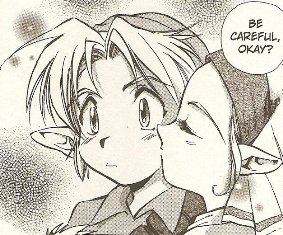 Link promises to get the other two stones and bring them back to Zelda. Before he left, Zelda kisses him on the cheek.
Link promises to get the other two stones and bring them back to Zelda. Before he left, Zelda kisses him on the cheek.
Zelda
has kissed Link before in previous games, but she never kisses Link in
Ocarina of Time. The writers probably decided to throw this in as a fan
service. A little stereotypical, but so was Link’s relationship with
Saria, so this addition comes with no surprise. While Link’s thoughts
were still reflecting on Zelda, Navi gets upset with Link reminding him
of Saria, as if implying that Saria is his girl rather than Zelda. Once
again, this is just a fan service in reference to all the debates
people have had in the past over who is Link’s girlfriend.
Link
plays his ocarina on his way to Death Mountain, which gets the
attention of the nearby Epona. Taking advantage of the situation, Link
rides the horse the rest of the way to Death Mountain, somehow
bypassing Kakariko Village. Young Link is not supposed to meet Epona
outside of Lon Lon Ranch until he is an adult. Establishing a
relationship with the horse while he is still a child is important, but
at this stage in the story, it seems a little early. As for the part
about bypassing Kakariko Village, the writers confused me for omitting
the town from Link’s path. The writers probably wanted to avoid
introducing another village due to pacing issues, but to invent new
paths in the environment is a little steep for artistic licensing.
After
traveling to Goron City, Link meets Darunia and makes a deal with him
to clear out Dodongo’s cavern in exchange for his spiritual stone. Link
recruits a young Goron to show him the way. So Link, Epona, and the
young Goron enter the cavern and instantly find Dodongo, once again
omitting the dungeon. The young Goron shows Link a bomb flower and Link
throws one into Dodongo’s mouth to defeat it. Darunia gives Link the
second spiritual stone, and the Gorons throw a huge celebration, during
which Epona runs away. So by now we can see the pattern the book takes
for dungeons. Link finds an assistant, both the Goron and Epona, he
skips the dungeon, and he defeats the boss with one blow. This
certainly takes away some of the complexity behind each dungeon.
Setting
off to find the last spiritual stone, Link finds himself near Lon Lon
Ranch. Epona recognizes Link and greets him, which gains Malon’s
attention. So excited to have a visitor, Malon shows Link around the
ranch. Kaepora Gaebora sees Link at the ranch and offers to fly him to
Zora’s Domain. As they leave, Malon asks Link to come back soon. Navi
then teases Link referring to his three girls.
 Once again, an obvious note to the fan service love circle, leaving just one key left.
Once again, an obvious note to the fan service love circle, leaving just one key left.In
Zora’s Domain, King Zora informs Link of Ruto, and sends him to find
her in exchange for the last spiritual stone. Inside, Link finds her
just before Barinade with the Spiritual Stone of Water located beneath
the monster. Ruto greets Link with the same high and mighty royalty
attitude from the game, but once he defeats Barinade, by using his
sword for the first time in the book, she of course opens up. She
reveals to Link that she ran away because her father was arranging for
her to marry another Zora. In the game, she had simply lost the Zora’s
Sapphire and wanted to get it back, but the manga’s version does add a
new bit of depth to her character. Link tells her that he envies her
and her father, in reference to missing his father figure, the Deku
Tree, who had died earlier. Touched by his sensitivity, she gives the
stone to Link informing him that he was now her fiancé. Not knowing
what this meant, Link accepts and heads back to the castle.
Link
sees the castle burning off in the distance and quickly arrives to see
Ganondorf’s minions destroying the town. Link tries to fight a Stalfo,
but his sword is ineffective. Zelda and Impa ride past Link on
horseback when Zelda throws the Ocarina of Time to him. Ganondorf sees
Link pick up the Ocarina and tells him to give it to him. This is very
odd, because in the game, Ganondorf asks Link which direction Zelda
went, but in the manga, he doesn’t seem interested in her. Instead, he
wants the Ocarina. Perhaps he wanted to open the sacred realm himself
with it, but later we will see that this is not the case. It makes much
more sense for Ganondorf to want to capture Zelda, but his odd
obsession with the Ocarina of Time is really unfounded. Link manages to
drop Saria’s Ocarina by accident, and Ganondorf mistakes it for the
real Ocarina of Time. Sure, it gives a nice purpose behind Saria’s
Ocarina, but the writers leave the reader wondering why Ganondorf
wanted the Ocarina of Time rather than Princess Zelda.
Immediately
after Ganondorf leaves, Link goes to the Temple of Time and opens the
door of time. Link finds the Master Sword and pulls it from the stone,
sending him seven years into the future. Link meets Rauru in the
Chamber of Sages where he explains to Link how Ganondorf has entered
the Sacred Realm and has claimed Hyrule. Rauru tells Link he must
awaken the five other sages in order to defeat Ganondorf. As an adult,
Link sets out once again to save Hyrule. Link steps outside the Temple
of Time to find a castle guard fighting off a group of Stalfos.

This
must have been one dedicated soldier because before Link left, the
castle was already on fire and under siege by Ganondorf’s army, then
seven years later, this one man was still fighting. Either this guard
held off armies by himself for seven years, or he randomly decided to
come back by himself several years later and try to take back the
kingdom. Whatever the writers were thinking, they didn’t try too hard
to explain this new background character which left the reader
scratching their heads. It was a nice idea to have guards fighting off
Ganondorf’s minions, but the timing here was really far off. Link
fights off the Stalfos and begins to wander the wasteland that was once
Hyrule.
The story shifts focus to Ganondorf, inside of his
castle. He crushes the fake ocarina and curses the boy for tricking
him. This scene is even more confusing than the last. Remembering the
fact that Ganondorf has an unfounded obsession with the Ocarina of
Time, here we see him just now checking the ocarina he took seven years
ago. If the Ocarina was so important to him, why didn’t he check it
sooner? Seven years is a very long time to sit around with a fake
ocarina. Also, after seven years of not using the Ocarina, why did he
suddenly need it now? The Door of Time was already opened for him by
Link, he had already visited the sacred realm, and he had already
obtained a piece of the triforce. The Ocarina of Time can’t serve him
any other purpose unless he just really likes quality music.
A
defeated Stalfo reports to Ganondorf about the Hero of Time and the
Master Sword. One bystanding Gerudo asks if the Hero of Time had the
Ocarina, proving even more how obsessed they all were for it. Ganondorf
then declares they must seize the Ocarina of Time before Link learns
how to properly use the Master Sword.
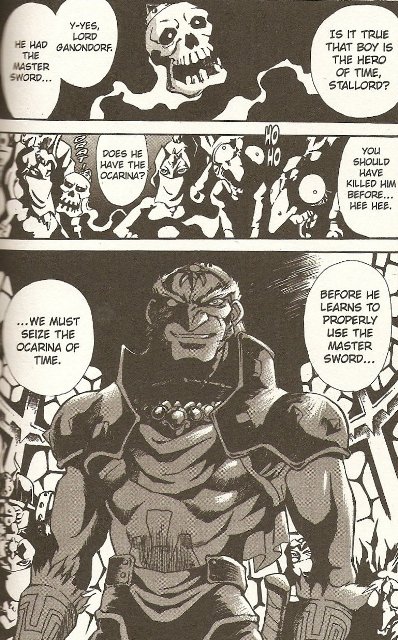
Once
again, why do they even care? In the game, Ganondorf never even
mentions the Ocarina of Time. In fact, once Link is an adult, the
Ocarina doesn’t play much of a part aside from a few helpful
teleportation songs. The Ocarina is still very important to the game,
but not nearly as much as the book is trying to make it out to be.
Link
travels back to the Kokiri Forest to find Mido. Link and Mido once
again team up to find the Forest Temple. After briefly wandering the
temple, Phantom Ganon makes his appearance. Mido finds a bow inside the
dungeon, for once, and Link shoots Phantom Ganon inside a painting to
defeat him. Saria appears and informs Link that she has awakened as a
sage. It is nice to have Link actually find an item inside the temple,
and for a few panels, Link and Mido do get to wander the Forest Temple.
This was still a very simplified version of the temple, but the writers
did try harder on this dungeon then the previous ones. Link leaves the
forest and heads back to Death Mountain, once again completely
bypassing Kakariko Village somehow.
The next chapter skips ahead
straight to a fight with Volvagia, with little explanation. It felt a
little rushed, considering how much time the story has spent outside of
the temples, but perhaps the writers were just changing to a more
action oriented pacing now that Link was an adult. Link is once again
with another Goron, probably the same one from before. For some reason
Link hesitates and takes a critical blow from Volvagia. When Link
regains consciousness, he meets Sheik who had saved him and treated his
wounds. Link explains to Sheik his unknown relationship with Volvagia.
Apparently, at some point when Link was a child in Castle Town, he
bought a pet dragon that learned how to say his name, kind of like a
parrot.
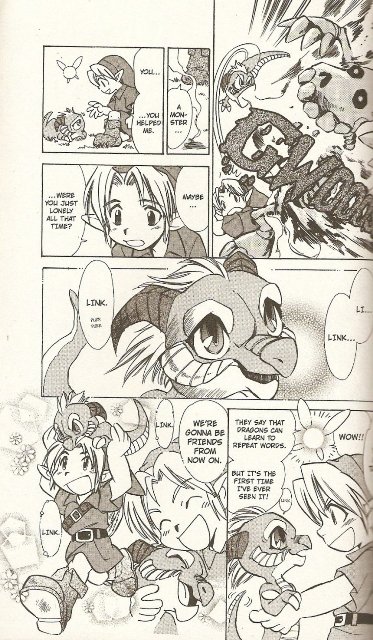
This
never happened in the game, but the fact that they wanted to add a bit
of personality to Volvagia is fun idea. However, this chapter is all
over the place. They skip straight to the fight, and then Link has a
flash back that basically says by the way, in addition to what you read earlier, this origin story fits in somehow.
Basically this sub story really feels like a last minute decision that
intended to be creative but instead turned out looking very lazy. Would
it have been so hard to have Link buy that dragon several chapters ago
when he unknowingly met Zelda in Castle Town? The way they wrote it, it
leaves the reader, once again, scratching their head trying to figure
out exactly what the writer was thinking.
Sheik tries to
motivate Link to face Volvagia again. Link tries to remind Volvagia who
he was, but it was to no avail and in the end cuts his head off.
Volvagia, still alive for some reason, softly says “Link” before
finally dying. This whole chapter could have been a very creative
addition to the game, but instead it was devastated with poor planning
leaving us with nothing more than a missed opportunity.
In
probably the most interesting development in the book, Sheik is then
seen kneeling before Ganondorf reporting the results of the battle with
Volvagia. She informs Ganondorf that Link’s spirits are down after
killing his friend and now is the time to strike. Ganondorf then asks
Sheik about the search for Zelda stating “we cannot let those two find one another”.
This was a nice relief considering this is the first time in the entire
book that Ganondorf showed any interest in capturing Zelda, since
before he’s been only focused on finding the Ocarina. Having Sheik be
Ganondorf’s spy is a very unique addition, roughly explaining some of
her secrecy seen from the game. With such an interesting development,
the writers can really add a lot of new elements to the story.
Link
travels back down the mountain and begins to feel very thirsty. Once
completely exhausted, Link finds Kakariko Village, for the first time.
Just before reaching the village, Impa attacks him catching Link off
guard. Impa recognizes him and then promptly scolds him for foolishly
traveling such a vast distance without water, and then letting his
guard down. A few questions arise from this scene. First of all, where
was Link traveling? Death Mountain isn’t that far away from the
Kakariko village. It is nice to see the writers make Hyrule appear much
bigger than in the game, but at this point it is really hard to tell
where Kakariko Village is. Apparently Link can travel to Death Mountain
without going through the village, and it also lies a great distance
from Death Mountain since Link exhausted himself traveling there.
Artistic licensing is one thing, but ignoring the source material is
another. Since the game series puts so much enthuses on exploration,
the writers probably decided to make this area have huge landscapes to
compensate for the lack of any actual exploration. It is a cool aspect
that really gets the reader to ponder how big the landscapes from
Ocarina of Time could have been had there not been any technological
limitations for the Nintendo 64.
Impa and the villagers feed
Link, and Impa continues to scold Link for his carelessness. Link asks
for Impa to train him how to be a better fighter. After several days of
training, Link’s skill begins to improve. At one point, Link gets a
drink from the well when suddenly a black shadow appears and forms into
Dark Link. In the game, Dark Link is in the Water Temple, but it
actually plays out well here. The well served as a pre-dungeon before
entering the Shadow Temple. Since Dark Link basically shadows all of
Links abilities, it actually makes a fair amount of sense to have Dark
Link be attributed to the Shadow Temple rather than the Water Temple in
the first place. So, props to the writers for thinking up this
plausible alteration.
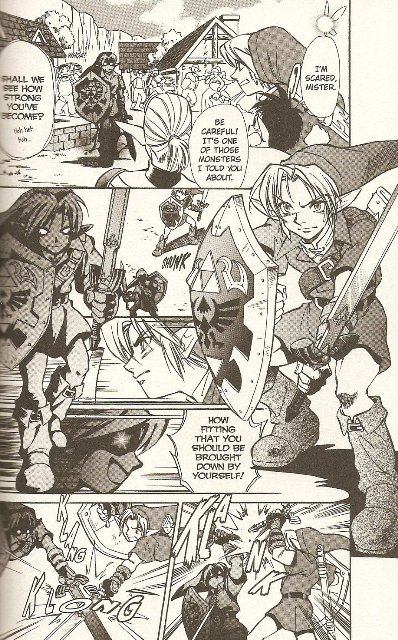
All
of Link’s training is put to the test against Dark Link. After probably
the nicest looking battle in the entire book, Link defeats the dark
shadow. Impa, proud of Link’s progress, pierces his ear with an earring
which Impa calls the coming of age ritual piece of the
Sheikah. The game never tries to explain how Link acquires these
earrings in between childhood and adulthood. We can only assume Rauru
pierced his ears in his sleep, which is kind of creepy. Link says his
goodbyes and leaves Kakariko village, ending the first volume.
 Despite
Despite
a bad first impression, by incorrectly dating the Ocarina of Time game,
the book still turned out very pleasant. My initial concerns were how
well the Japanese would translate into English, and there were only a
few instances that didn’t quite work. At one point when Link was
talking with Zelda, he said: “Are you sure you should be telling tell me something so important, Zelda?”
This
may just be another bad job of editing, but it could have also been
just a bad translation. The quote is incorrectly translated and should
have been fixed before being published.
 At one point, Link calls Impa “ma’am”, which oddly offends her for some reason. In a fan translation, the translator said that the word used here was supposed to mean something to the extent of “old lady”
At one point, Link calls Impa “ma’am”, which oddly offends her for some reason. In a fan translation, the translator said that the word used here was supposed to mean something to the extent of “old lady”
but it was for some reason hard to translate appropriately. Ma’am,
however, is a very respectable title that demonstrates authority rather
than age, so having Impa react negatively to ma’am doesn’t make
any sense in North American culture. This mistake could have been fixed
had the publisher put forth the effort to notice. Finally, in chapter
5, Link meets the Zoras who supposedly speak with some form of accent.
When the Gorons speak, they occasionally end their sentences with “Goro,” which does occur in some Legend of Zelda games. Comparatively, the Zoras for some reason do something similar by saying “Zora” after their sentences.
In
the game, Zoras never speak like this. Perhaps they did something
similar in the Japanese version, but if that is the case, they still
should have fixed the translation to match the North American version.
Otherwise it looks like a cheap knock-off of Goron speech.
 Besides
Besides
these mistakes, the translation still stands pretty solid. Some fan
translations tried to fit in curse words to add maturity to the book,
which really looked inconsistent with the series, but the official
translation made much more sense in regards to the family friendly
Nintendo product. The question still stands of whether or not the book
is worth the eight dollars.
Chances are, the market that would
want to read this manga have already done so. The Japanese version came
out ten years ago, and numerous fan translations have been available
for free for quite some time. For those who would prefer to read the
fan translations for free, you are really missing out. While the
official translation was overlooked in certain areas, it is still a
solid read. The artwork looks great, all directly inspired by the
official artwork published by Nintendo.
 Also,
Also,
in fan translations, artwork always has Japanese symbols plaguing each
page to simulate sounds. In the official translation, all of these
symbols are artistically replaced with English which completely changes
numerous panels. So to get the full experience, the official
translation is the only way to go, even if you’ve read it before.
The
more people that take interest in this book, the bigger message we will
send to Nintendo. Numerous Legend of Zelda manga books have been
announced for localization, but that doesn’t necessarily make it
definite. If this book doesn’t sell well enough, future projects may be
canceled. If sales are good, Nintendo might consider localizing more.
With enough of a reader fan base, Nintendo could also get the message
that story is important to their fans. In recent Legend of Zelda games,
story has taken a backseat. Gameplay should always be top priority, but
fans, like me, also crave a new intriguing story for the franchise. The
manga does nothing but focus on story, so if sales are noticeably high,
Nintendo may venture into those uncharted waters. Manga also has a
tendency to turn into television adaptations as well, like Naruto,
Yugioh, Dragon Ball Z, etc., but only if popularity remain consistent.
Steve
Martin Link will always haunt us, but that shouldn’t prevent Nintendo
from trying again, this time with a lot more care and quality. With
enough devotion, the Legend of Zelda could make a great animated
series; however, paying no attention once again will leave us with
things like Super Mario Bros. Super Show. For the truly hopeful, these
books could be the initial steps taken towards the Legend of Zelda
movie. Video Games are infamously bad at becoming movies, but books,
and recently comic books, have been made into some of the greatest
movies of the modern era. If the Legend of Zelda manga gets popular
enough, Nintendo might be motivated to write a book into a script.
There is a lot of potential here to expand the Legend of Zelda
franchise into new mediums, and right now Nintendo is testing the water
with manga for western audiences. Should we choose to ignore this
trial, then we’ll always get what we always had, but if we show the
slightest interest, it could open the door wide open for new ideas.



